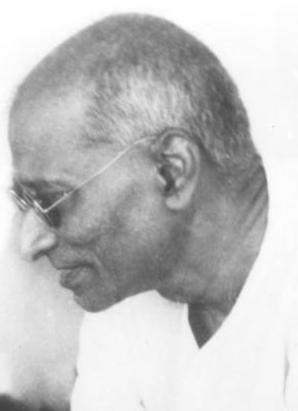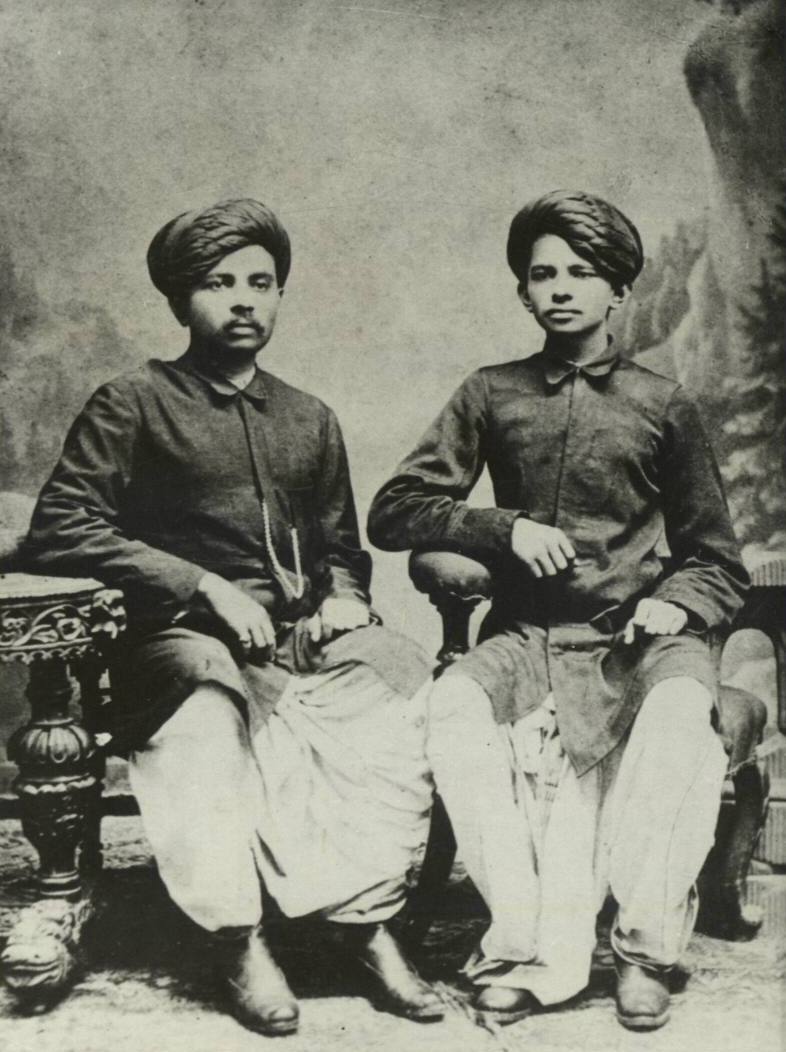|
Eknath Ranade
Eknath Ramakrishna Ranade (pronunciation: ekᵊn̪at̪ʰ ɾɑmɐkr̩ʂɳə ɾäɳäɖe) (19 November 1914 – 22 August 1982) was an Indian social activist and right-wing leader. He joined the Rashtriya Swayamsevak Sangh (RSS) while still in school, and served as the general secretary from 1956 to 1962. Ranade was greatly influenced by the teachings of Swami Vivekananda, and compiled a book of Vivekananda's writings. He played a significant role in the construction of the Vivekananda Rock Memorial and the Vivekananda Kendra at Kanyakumari, Tamil Nadu. Early life and education Ranade was born on 19 November 1914 in Timtala, Amravati district, in the British Indian state of Maharashtra. In 1920, his family moved to Nagpur, and he attended Pradanavispura School for his primary education. In 1932, he passed his matriculation examination from the New English High School in Nagpur. After getting a Master of Arts degree in philosophy with honours, he went on to earn an LL.B. fr ... [...More Info...] [...Related Items...] OR: [Wikipedia] [Google] [Baidu] |
Amravati District
Amravati district (Marathi pronunciation: Help:IPA/Marathi, [əmɾaːʋət̪iː]) is a Districts of Maharashtra, district of Maharashtra state in central India. It is the administrative headquarter of Amravati division, which is one of the two divisions in Vidarbha (other being Nagpur), out of total 6 Regions and Divisions of Maharashtra, regions in state of Maharashtra. The district is situated between 20°32' and 21°46' north latitudes and 76°37' and 78°27' east longitudes. The district occupies an area of 12,235 km2. The district has boundaries with Betul District of Madhya Pradesh state to the north, and with the Maharashtra districts of Nagpur District, Nagpur to the northeast, Chhindwara district of Madhya Pradesh to the northeast Wardha District, Wardha to the east, Yavatmal District, Yavatmal to the south, Washim District, Washim to the southwest, and Akola District, Akola and Buldhana District, Buldhana districts to the west. History In 1853, the present terri ... [...More Info...] [...Related Items...] OR: [Wikipedia] [Google] [Baidu] |
Nagpur
Nagpur (; ISO 15919, ISO: ''Nāgapura'') is the second capital and third-largest city of the Indian state of Maharashtra. It is called the heart of India because of its central geographical location. It is the largest and most populated city in central India. Also known as the "Orange City", Nagpur is the 13th largest city in India by population. According to an Oxford's Economics report, Nagpur is projected to be the fifth fastest growing city in the world from 2019 to 2035 with an average growth of 8.41%. It has been proposed as one of the Smart Cities Mission, Smart Cities in Maharashtra and is one of the top ten cities in India in Smart Cities Mission, Smart City Project execution. Nagpur is the seat of the annual Winter Session of Maharashtra State Assembly, winter session of the Maharashtra state assembly. It is a major commercial and political centre of the Vidarbha Regions and Divisions of Maharashtra, region of Maharashtra. In addition, the city derives unique importa ... [...More Info...] [...Related Items...] OR: [Wikipedia] [Google] [Baidu] |
Constitution
A constitution is the aggregate of fundamental principles or established precedents that constitute the legal basis of a polity, organization or other type of entity, and commonly determines how that entity is to be governed. When these principles are written down into a single document or set of legal documents, those documents may be said to embody a ''written constitution''; if they are encompassed in a single comprehensive document, it is said to embody a ''codified constitution''. The Constitution of the United Kingdom is a notable example of an ''uncodified constitution''; it is instead written in numerous fundamental acts of a legislature, court cases, and treaties. Constitutions concern different levels of organizations, from sovereign countries to companies and unincorporated associations. A treaty that establishes an international organization is also its constitution, in that it would define how that organization is constituted. Within states, a constitution ... [...More Info...] [...Related Items...] OR: [Wikipedia] [Google] [Baidu] |
Minister Of Home Affairs (India)
The Minister of Home Affairs is the head of the Ministry of Home Affairs of the Government of India. One of the senior-most officers in the Union Cabinet, the chief responsibility of the home minister is the maintenance of the internal security of India; the country's large police force comes under its jurisdiction. Occasionally, they are assisted by the minister of state of home affairs and the lower-ranked deputy minister of home affairs. Ever since the time of independent India's first home minister, Sardar Vallabhbhai Patel, the office has been seen as second in seniority only to the prime minister in the union cabinet. Like Patel, several home ministers have since held the additional portfolio of deputy prime minister. As of February 2020, three home ministers have gone on to become the prime minister: Lal Bahadur Shastri, Charan Singh and P. V. Narasimha Rao. L.K. Advani, serving from 19 March 1998 to 22 May 2004, has held the office of the home minister for the longe ... [...More Info...] [...Related Items...] OR: [Wikipedia] [Google] [Baidu] |
Sardar Vallabhbhai Patel
Vallabhbhai Jhaverbhai Patel (; ''Vallabhbhāī Jhāverbhāī Paṭel''; 31 October 1875 – 15 December 1950), commonly known as Sardar Vallabhbhai Patel, was an Indian independence activist and statesman who served as the first Deputy Prime Minister of India, Deputy Prime Minister and Home Minister of India from 1947 to 1950. He was a senior leader of the Indian National Congress, who played a significant role in the Indian independence movement and India's Political integration India, political integration. In India and elsewhere, he was often called ''Sardar'', meaning "Chief" in Hindustani language, Hindustani, Bengali language, Bengali, Persian language, Persian and Prakrit. He acted as the Minister of Home Affairs (India), Home Minister during the political integration of India and the Indo-Pakistani War of 1947. Patel was born in Nadiad city at Bombay Presidency (present-day Kheda district, Gujarat) and raised in the countryside of the state of Gujarat. He was a success ... [...More Info...] [...Related Items...] OR: [Wikipedia] [Google] [Baidu] |
Satyagraha
Satyāgraha (from ; ''satya'': "truth", ''āgraha'': "insistence" or "holding firmly to"), or "holding firmly to truth",' or "truth force", is a particular form of nonviolent resistance or civil resistance. Someone who practises satyagraha is a satyagrahi. The term ''satyagraha'' was coined and developed by Mahatma Gandhi (1869–1948) as early as 1919. Gandhi practised satyagraha as part of the Indian independence movement and also during his earlier struggles in South Africa for Indian rights. Satyagraha theory influenced Martin Luther King Jr.'s and James Bevel's campaigns during the Civil Rights Movement in the United States, as well as Nelson Mandela's struggle against apartheid in South Africa and many other social-justice and similar movements. Principles Gandhi envisioned ''satyagraha'' as not only a tactic to be used in acute political struggle but as a universal solvent for injustice and harm. He founded the Sabarmati Ashram to teach ''satyagraha''. He ask ... [...More Info...] [...Related Items...] OR: [Wikipedia] [Google] [Baidu] |
Mahatma Gandhi
Mohandas Karamchand Gandhi (2October 186930January 1948) was an Indian lawyer, anti-colonial nationalism, anti-colonial nationalist, and political ethics, political ethicist who employed nonviolent resistance to lead the successful Indian independence movement, campaign for India's independence from British Raj, British rule. He inspired movements for Civil rights movements, civil rights and freedom across the world. The honorific ''Mahātmā'' (from Sanskrit, meaning great-souled, or venerable), first applied to him in Union of South Africa, South Africa in 1914, is now used throughout the world. Born and raised in a Hindu family in coastal Gujarat, Gandhi trained in the law at the Inner Temple in London and was called to the bar at the age of 22. After two uncertain years in India, where he was unable to start a successful law practice, Gandhi moved to South Africa in 1893 to represent an Indian merchant in a lawsuit. He went on to live in South Africa for 21 years. Here, ... [...More Info...] [...Related Items...] OR: [Wikipedia] [Google] [Baidu] |
RSS Pracharak
The Rashtriya Swayamsevak Sangh (RSS,, ) is an Indian right-wing, Hindu nationalist volunteer paramilitary organisation. It is the progenitor and leader of a large body of organisations called the Sangh Parivar (Hindi for "Sangh family"), which has developed a presence in all facets of Indian society and includes the Bharatiya Janata Party (BJP), the ruling political party under Narendra Modi, the prime minister of India. Mohan Bhagwat has served as the '' Sarsanghchalak'' of the RSS . Founded on 27 September 1925, the initial impetus of the organisation was to provide character training and instil "Hindu discipline" in order to unite the Hindu community and establish a '' Hindu Rashtra'' (Hindu nation). The organisation aims to spread the ideology of Hindutva to "strengthen" the Hindu community and promotes an ideal of upholding an Indian culture and its civilizational values. On the other hand, the RSS has been described as "founded on the premise of Hindu supremacy", ... [...More Info...] [...Related Items...] OR: [Wikipedia] [Google] [Baidu] |
Madhya Pradesh
Madhya Pradesh (; ; ) is a state in central India. Its capital is Bhopal and the largest city is Indore, Indore. Other major cities includes Gwalior, Jabalpur, and Sagar, Madhya Pradesh, Sagar. Madhya Pradesh is the List of states and union territories of India by area, second largest Indian state by area and the List of states and union territories of India by population, fifth largest state by population with over 72 million residents. It borders the states of Rajasthan to the northwest, Uttar Pradesh to the northeast, Chhattisgarh to the east, Maharashtra to the south, Gujarat to the west. The area covered by the present-day Madhya Pradesh includes the area of the ancient Avanti (India), Avanti Mahajanapada, whose capital Ujjain (also known as Avantika) arose as a major city during the second wave of Indian urbanisation in the sixth century BCE. Subsequently, the region was ruled by the major dynasties of India. The Maratha Confederacy, Maratha Empire dominated the maj ... [...More Info...] [...Related Items...] OR: [Wikipedia] [Google] [Baidu] |
Mahakoshal
Mahakoshal or Mahakaushal is a region of central India. Mahakoshal lies in the upper or eastern reaches of the Narmada River valley in the Indian state of Madhya Pradesh. Jabalpur is the largest city in the region. Nimar region lies to the west, in the lower reaches of the Narmada valley. Mahakoshal is now predominantly a Hindi-speaking area, although it is actually the native region of Dravidian languages such as Gondi, Pardhan and Bharia. Due to the prevalence of Gondi the region is also called Gondwana by Gondi speakers. Other languages used in the region include Bagheli and Marathi. Geography The Vindhya Range forms the northern boundary of the region; north of the Vindhya Range lie the regions of Malwa to the northwest, Bundelkhand to the north, and Bagelkhand to the northeast. Chhattisgarh state lies to the east, and the Vidarbha region of Maharashtra state lies to the south across the Satpura Range. Cities and districts of the region include Jabalpur, Shahdol, ... [...More Info...] [...Related Items...] OR: [Wikipedia] [Google] [Baidu] |
Hindu Nationalism
Hindu nationalism has been collectively referred to as the expression of political thought, based on the native social and cultural traditions of the Indian subcontinent. "Hindu nationalism" is a simplistic translation of . It is better described as "Hindu polity". The native thought streams became highly relevant in Indian history when they helped form a distinctive identity about the Indian polityChatterjee Partha (1986) and provided a basis for questioning colonialism.Peter van der Veer, Hartmut Lehmann, Nation and religion: perspectives on Europe and Asia, Princeton University Press, 1999 p. 90 These also inspired Indian nationalism, Indian nationalists during the Indian independence movement, independence movement based on armed struggle,Li Narangoa, R. B. Cribb ''Imperial Japan and National Identities in Asia'', 1895–1945, Published by Routledge, 2003 p. 78 coercive politics,Bhatt, Chetan, ''Hindu Nationalism: Origins, Ideologies and Modern Myths'', Berg Publishers (20 ... [...More Info...] [...Related Items...] OR: [Wikipedia] [Google] [Baidu] |






